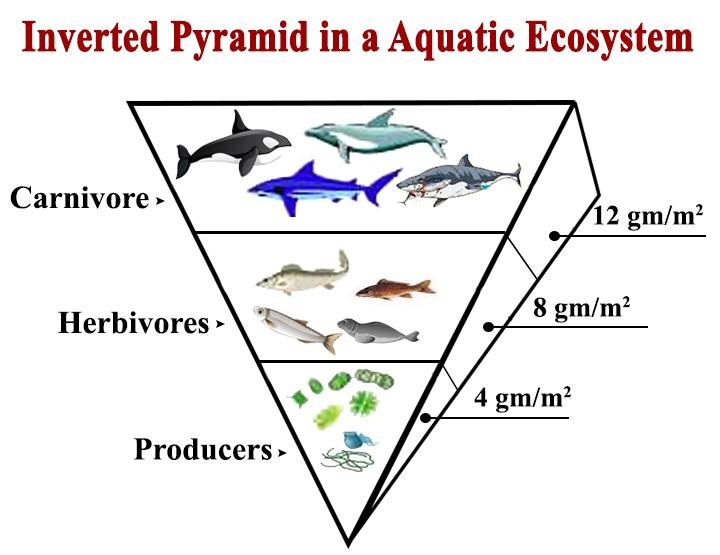
Pyramid of biomass indicates?
A) Biotic potential
B) Standing crop
C) Standing state
D) Productivity
Answer
581.4k+ views
Hint: Pyramids of biomass are calculated by gathering all the organisms living at each trophic level separately, and then by measuring their dry weight.
Complete answer:
Each trophic level has a certain mass of living material at a particular time is termed as the standing crop. The standing crop is measured as the mass of living organisms that is biomass or the number of living organisms in a unit area.


Additional information:
As the name suggests, pyramids of biomass show the amount of biomass (living or organic matter present in an organism) present per unit area at each trophic level. It is drawn as the producers at the base and the top carnivores at the tip.
Each trophic level contains a specific mass of living material at a particular time called standing crop, which is measured as the mass of living organisms (biomass) or the number in a unit area.
It can be upright or inverted.
In terrestrial ecosystems, such as cropland, grassland and forest, there is progressive decrease in biomass from lower to higher trophic levels. So, the pyramid of biomass is upright.
In aquatic ecosystems, such as lakes and ponds, there is progressive increase in the successive trophic levels. So, the pyramid of biomass is inverted.
When the biomass pyramid is upright, the producers have maximum biomass, and decomposers have the minimum. When the biomass pyramid is inverted, the producers are small-sized with low biomass, whereas the consumers are large-sized with high biomass.
So, the correct answer is ‘standing crop’.
Note: The biomass of a species is expressed in terms of fresh or dry weight. And among them, measurement of biomass in terms of dry weight is more accurate than the other.
Complete answer:
Each trophic level has a certain mass of living material at a particular time is termed as the standing crop. The standing crop is measured as the mass of living organisms that is biomass or the number of living organisms in a unit area.


Additional information:
As the name suggests, pyramids of biomass show the amount of biomass (living or organic matter present in an organism) present per unit area at each trophic level. It is drawn as the producers at the base and the top carnivores at the tip.
Each trophic level contains a specific mass of living material at a particular time called standing crop, which is measured as the mass of living organisms (biomass) or the number in a unit area.
It can be upright or inverted.
In terrestrial ecosystems, such as cropland, grassland and forest, there is progressive decrease in biomass from lower to higher trophic levels. So, the pyramid of biomass is upright.
In aquatic ecosystems, such as lakes and ponds, there is progressive increase in the successive trophic levels. So, the pyramid of biomass is inverted.
When the biomass pyramid is upright, the producers have maximum biomass, and decomposers have the minimum. When the biomass pyramid is inverted, the producers are small-sized with low biomass, whereas the consumers are large-sized with high biomass.
So, the correct answer is ‘standing crop’.
Note: The biomass of a species is expressed in terms of fresh or dry weight. And among them, measurement of biomass in terms of dry weight is more accurate than the other.
Recently Updated Pages
Master Class 12 Business Studies: Engaging Questions & Answers for Success

Master Class 12 Economics: Engaging Questions & Answers for Success

Master Class 12 English: Engaging Questions & Answers for Success

Master Class 12 Maths: Engaging Questions & Answers for Success

Master Class 12 Social Science: Engaging Questions & Answers for Success

Master Class 12 Chemistry: Engaging Questions & Answers for Success

Trending doubts
Who was the first woman to receive Bharat Ratna?

Write a letter to the principal requesting him to grant class 10 english CBSE

Why is there a time difference of about 5 hours between class 10 social science CBSE

What is the median of the first 10 natural numbers class 10 maths CBSE

The Equation xxx + 2 is Satisfied when x is Equal to Class 10 Maths

Discuss the main reasons for poverty in India




